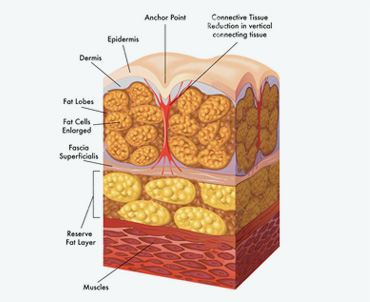
Microneedling for cellulite
by Cellulite Institute editorial staff

Microneedling for cellulite
Microneedling for cellulite is a treatment for the body, an innovative technique in aesthetic medicine based on stimulation and promotion of collagen formation.
The technique uses small needles to create micro-lesions on the skin and thus induce the production of collagen and elastin associated with a preparatory treatment using vitamin A or its topical precursors.
The skin repair process is reflected in general improvement of the epidermis.
Microneedling for cellulite: what is it?
Needling is a treatment for the skin that uses a device specifically designed for this purpose; it has a pen shape and is fitted with very thin needles.
It is a medical device used for:
- destroying old scar tissue
- stimulating the skin cells to regenerate themselves
This regenerating action on cells called fibroblasts causes the formation of:
- New tissue layers
- Elastin and collagen fibres
- New capillaries for improved blood supply
Microneedling for cellulite: what does the treatment involve?
The device slides along the skin, penetrating the upper layers of the epidermis with needles to a maximum depth of 2 mm; in this way, the needles cause numerous small surface bruises.
Through the creation of new collagen and elastin fibres, the procedure stimulates the body to respond to the skin damage caused by the needles.
The doctor performing the treatment applies a thin layer of topical gel and select the depth required for treatment according to specific individual needs.
The device is applied until the entire treatment area is completed.
Microneedling for cellulite: what are the advantages?
Needling offers the following benefits:
- Attenuation of stretch marks
- A fresher, brighter and more compact appearance of the skin over the whole body
Microneedling for cellulite: which body areas can be treated?
This treatment can be performed easily on all parts of the body such as:
- Face
- Neck
- Cleavage
- Arms
- Hands
- Legs
- Abdomen
- Back
Microneedling for cellulite: what do you feel?
The sensation experienced during treatment is similar to that of an abrasion.
While some areas are more sensitive than others, the alternating speed of the needle tip reduces discomfort and application of a moisturising gel makes the treatment more tolerable.
Microneedling for cellulite: how long does a session last?
The procedure takes 15 to 30 minutes depending on the size of the area to be treated.
Microneedling for cellulite: how long does convalescence last?
Immediately after treatment, redness of the skin will be noticed.
The total healing time depends on the depth of the treatment and is usually individual.
Some patients heal completely in just 24-48 hours.
Microneedling for cellulite: results
Visible changes occur over several days and weeks. The results continue to improve up to 6 months after treatment.
Microneedling for cellulite: how many treatment sessions are needed?
Some patients require 1 treatment session once a year to achieve the desired results. However, in most cases it is recommended undergoing a series of 3 to 4 treatments, 6 to 8 weeks apart.
For patients with stretch marks, at least 6 to 8 sessions are recommended, at 6-week intervals.
Microneedling for cellulite: Cellulite, an enemy to know
Like any enemy that is respected, it is good to know it for having any hope of defeating it. Cellulite has more than one name, in fact it is also known as fibrous edematous panniculopathy and gynoid lipodystrophy.
In essence, it is a skin manifestation characterised by a series of depressions present mainly on the buttocks, the abdominal and pelvic areas, and on the hips and thighs.
The visual effect is reminiscent of the peel of some citrus fruits which is why cellulite is also known as “orange peel”.
Despite the names used to define cellulite, it cannot be termed a disease; indeed some doctors define it as a non-disease insofar as, apart from blemishes, it has no symptoms which lead to it being considered a normal physical condition.
In some cases however, cellulite can be considered pathological, that is when it is manifested with nodules that cause pain and is therefore linked to an inflammatory process.
Besides the purely aesthetic issue and severe cases, cellulite may be indicative of a less than ideal physical condition insofar as it is associated with an excessive build-up of adipose tissue that may be related to cardiovascular disorders.
Microneedling for cellulite: causes and classification
Despite the fact that cellulite has been at the centre of studies and research for years, the causes of cellulite remain unclear. Various different theories have been formulated but they are the subject of controversy.
The following are often singled out:
- Metabolic disorders
- Nutritional disorders
- Hormonal factors
- Genetic factors
- Alterations in the lymphatic system
Nevertheless, the most common opinion is that cellulite is actually the result of a chain of several causes and is multifactorial.
Cellulite can, however, be classified. In fact, a scale has been established with 4 stages:
- Stage 0 indicates the complete absence of cellulite
- Stage 1 occurs when the skin appears smooth, but has an orange peel appearance if pinched or when the muscles contract
- Stage 2 is characterised by clearly visible dimpling even without stress on the skin
- Stage 3 has the same conditions as stage 2 but in a more extended form and also with the presence of nodules.
We must be wary of those who propose microneedling for cellulite as miraculous for eliminating cellulite, because it can only lead to an improvement.



